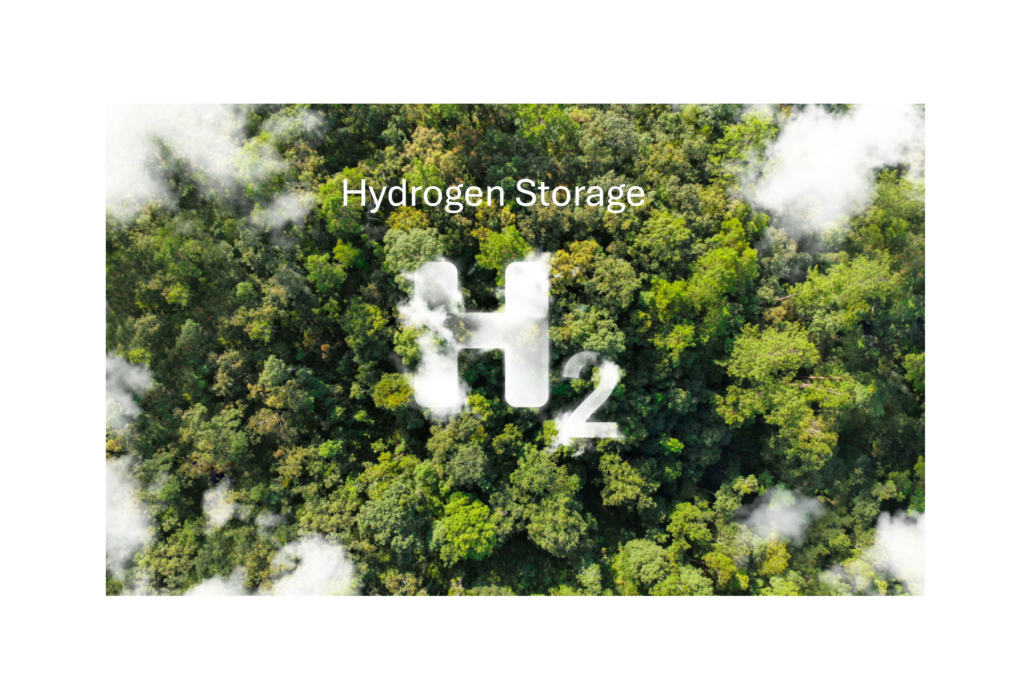As the world pushes forward in the quest to decarbonize and transition to renewable energy sources, hydrogen has emerged as a promising solution. Hydrogen, when used as an energy carrier, can serve as a clean fuel for various applications, ranging from transportation to industrial processes to power generation. However, one major challenge that has hindered the widespread adoption of hydrogen as a sustainable energy source is its storage. In this blog, we’ll explore the different methods of hydrogen storage, why it’s crucial for the hydrogen economy, and the innovative developments that are paving the way for more efficient and scalable storage solutions.
Executive Summary
Hydrogen storage technologies are at the forefront of the energy transition, enabling efficient storage and transportation of clean hydrogen. Agastya Hydrogen is addressing this critical challenge by innovating in high-efficiency metal hydride storage, advanced composite materials for compressed hydrogen storage, and integrating renewable energy solutions with hydrogen production. We are developing scalable storage solutions that meet the growing demand for hydrogen across various sectors, from transportation to energy generation.
- Total Project Cost: The total project cost for Agastya Hydrogen’s advanced hydrogen storage solutions is estimated at $150 million over the next 5 years, which includes research and development, infrastructure build-out, and technology scaling.
- Expected Payback Period: Based on projected market demand and hydrogen pricing models, Agastya Hydrogen expects a payback period of approximately 7 to 9 years. The company anticipates steady revenue growth from both storage system sales and hydrogen storage services, with increasing demand in key markets such as fuel cell vehicles and industrial applications.
This project aligns with both the global push for cleaner energy solutions and the growing demand for hydrogen storage technologies. It presents an attractive opportunity for investors and decision-makers who are looking to be part of the renewable energy revolution.
The Importance of Hydrogen Storage
Hydrogen is the most abundant element in the universe, but it doesn’t exist naturally in its pure form on Earth. Instead, it is typically found in compounds like water or hydrocarbons, which need to be separated to produce pure hydrogen. Once produced, hydrogen needs to be stored in a way that allows it to be transported and used effectively. This is where storage technologies become critical.
- Energy Density: Hydrogen has a very low energy density in its gaseous form, meaning it takes up a lot of space to store the same amount of energy as other fuels.
- Transport and Distribution: Whether it’s being used in fuel cells, industrial applications, or for transportation, hydrogen needs to be stored in a safe and efficient manner for easy transport to where it’s needed.
- Renewable Energy Integration: Hydrogen can act as a form of energy storage, especially for renewable energy sources like wind and solar. When renewable energy production exceeds demand, excess electricity can be used to produce hydrogen through electrolysis, which can then be stored and used when energy demand is high.
Methods of Hydrogen Storage
Currently, there are three primary methods for storing hydrogen: compressed gas storage, liquid hydrogen storage, and solid-state storage. Let’s dive into each of these techniques, while also incorporating relevant data from white papers and research findings.
1. Compressed Gas Storage
Compressed hydrogen gas is one of the most common methods of storage and transportation. In this method, hydrogen gas is stored in high-pressure tanks, typically at pressures around 350 to 700 bar (5,000 to 10,000 psi).
- Pros:
- Relatively mature technology.
- Scalable and can be integrated into existing infrastructure, such as pipelines and refuelling stations.
- The technology has been used in applications like fuel cell vehicles.
- Cons:
- Requires significant energy to compress the gas to such high pressures.
- Storage tanks are heavy and bulky, making them less suitable for small-scale or portable applications.
- Hydrogen still has a lower volumetric energy density compared to liquid fuels.
Data Points from White Papers: According to a 2021 report by the International Energy Agency (IEA), hydrogen storage at high pressures (700 bar) requires approximately 35-40 kWh of energy per kilogram of hydrogen, primarily to overcome the thermodynamic losses in the compression process. This energy penalty makes it more expensive compared to other forms of energy storage.
Moreover, research published in the Journal of Power Sources (2022) highlights that while compressed gas storage can provide energy densities of approximately 5-6 MJ/L, future developments in composite materials and tank design could increase this to 7-8 MJ/L, making the technology more efficient.
2. Liquid Hydrogen Storage
In liquid hydrogen storage, hydrogen is cooled to extremely low temperatures (below -253°C), turning it into a cryogenic liquid. This method has a higher energy density than compressed gas storage, meaning more hydrogen can be stored in the same volume.
- Pros:
- Greater energy density than compressed gas, which makes it suitable for long-term storage and large-scale transportation.
- Hydrogen in liquid form can be stored and transported more easily over long distances (such as via tankers).
- Cons:
- Requires significant energy to maintain the cryogenic temperatures, making it energy intensive.
- The process of liquefying hydrogen is complex and expensive.
- It also involves some losses due to evaporation or boil-off of hydrogen during storage.
Data Points from White Papers: A white paper published by the U.S. Department of Energy in 2020 revealed that the process of liquefying hydrogen has an energy efficiency of about 50-60%, with the majority of energy loss attributed to the refrigeration required to cool the gas to cryogenic temperatures.
Moreover, liquid hydrogen has an energy density of 8.5 MJ/L, which is about 2.5 times higher than compressed hydrogen at 700 bar, making it particularly suitable for transportation sectors like aviation. A 2023 paper in Nature Communications also pointed out that while storage costs for liquid hydrogen are high due to the required infrastructure, they are expected to decrease by 30% by 2030 as economies of scale are realized and new liquefaction technologies are developed.
3. Solid-State Hydrogen Storage
Solid-state hydrogen storage involves storing hydrogen in a solid material, such as metal hydrides or other chemical compounds. In this method, hydrogen reacts with a metal or alloy to form a stable compound, which can later release hydrogen when heated or exposed to specific conditions.
- Pros:
- High volumetric energy density—hydrogen is stored more densely than in its gas or liquid form.
- More compact and lightweight than compressed gas storage.
- Safer, as it reduces the risks of explosions associated with high-pressure gas or cryogenic liquid hydrogen.
- Cons:
- Releasing hydrogen from solid-state storage materials requires energy input, and the process can be slow.
- Some materials for solid-state storage are expensive and may not be easily scalable for large-scale applications.
Data Points: A white paper from the European Hydrogen Association (2022) discusses the potential of metal hydrides, with materials such as magnesium hydride showing storage capacities of 6-7 wt% hydrogen. However, the paper also highlights that while these materials have a high volumetric energy density, their high reactivity and slow kinetics in the release of hydrogen make them less practical for rapid refueling in transportation.
Additionally, the International Journal of Hydrogen Energy (2023) reports that sodium alanate (NaAlH4) could achieve hydrogen release rates that meet the standards for automotive fuel cells, with 2.3 wt% hydrogen storage, though the material still needs further optimization in terms of thermal stability and reusability.
How Agastya Hydrogen is Tackling the Hydrogen Storage Challenge
Agastya Hydrogen, a forward-thinking company dedicated to addressing the challenges of hydrogen as a clean energy source, is playing a critical role in advancing hydrogen storage technologies. Their approach blends cutting-edge materials science with innovative storage solutions, and they are focusing on several key areas to optimize hydrogen storage efficiency.
1. High-Efficiency Metal Hydride Storage Systems
Agastya Hydrogen is actively working on developing advanced metal hydride storage systems. Metal hydrides, as discussed earlier, offer a higher volumetric density compared to gaseous hydrogen and can be safer than traditional compressed gas storage methods. Agastya is investing in the development of proprietary alloys that can store hydrogen at lower pressures and temperatures while maintaining high efficiency in hydrogen release and absorption cycles.
2. Low-Cost Composite Materials for Compressed Hydrogen Storage
Recognizing the high energy requirements and safety concerns associated with compressed gas storage, Agastya Hydrogen is developing next-generation composite materials for pressure vessels that could store hydrogen at 700 bar or higher without the significant weight and cost penalties of current metal-based containers.
3. Partnerships with Research Institutions
Agastya Hydrogen has also partnered with academic and industrial research institutions to accelerate the development of new storage materials and technologies. We have MoUs with a leading institution such as the University of Houston, Texas, and NIT Warangal. Ongoing research on hydrogen storage in liquid organic hydrogen carriers (LOHCs) and Green Ammonia. These compounds could offer a safer and more efficient way to store hydrogen for long-term and large-scale applications.
4. Innovating for Hydrogen Integration with Renewable Energy
Agastya is also integrating its hydrogen storage technologies with renewable energy solutions, particularly in solar and wind energy systems. By using excess renewable energy to produce hydrogen through electrolysis and then storing it in high-efficiency containers, Agastya is working toward a closed-loop renewable energy system.
Risk Assessment:
Green hydrogen storage presents several risks that need to be carefully managed to ensure safety and efficiency.
- Flammability: Hydrogen is highly flammable and can ignite easily. Proper handling and storage protocols are essential to prevent combustion and explosions.
- Embrittlement: Hydrogen can cause embrittlement in certain materials, which can compromise the integrity of storage tanks and pipelines. Using materials resistant to hydrogen embrittlement is crucial.
- Leakage: Hydrogen leaks can create flammable atmospheres, posing significant safety hazards. Regular inspections and maintenance of storage systems are necessary to detect and mitigate leaks.
- High Pressure: Storing hydrogen often requires high-pressure containers, which can be a threat to nearby communities in case of leaks or explosions. Ensuring robust design and safety measures for these containers is vital.
Environmental Impact
Hydrogen storage plays a crucial role in enabling the transition to clean energy. By optimizing hydrogen storage systems, Agastya Hydrogen is advancing energy technology and contributing to global sustainability goals.
Estimated Environmental Benefits:
- CO2 Reduction: Agastya’s storage solutions will facilitate the integration of hydrogen into the energy mix, potentially reducing 4.5 million tons of CO2 emissions per year by displacing fossil fuel use in the transportation and industrial sectors.
- Renewable Energy Integration: By providing efficient storage, Agastya supports the growth of renewable energy sources like wind and solar, enabling a 10-15% increase in the use of renewable energy by helping smooth out their intermittency.
Market Analysis
The global demand for hydrogen storage is growing rapidly as governments and industries seek to meet carbon reduction targets. According to recent reports, the hydrogen market is expected to grow from $150 billion in 2023 to over $350 billion by 2030, driven by the expansion of fuel cell vehicles, hydrogen-powered industrial processes, and clean energy systems.
How Agastya Meets Market Demand: Agastya Hydrogen’s innovative storage solutions cater to this increasing demand. By offering safe, efficient, and scalable hydrogen storage, Agastya is well-positioned to serve key markets, including:
- Transportation: Fuel cell vehicles (FCVs), aviation, and heavy-duty transport.
- Energy Storage: Grid balancing, backup power, and renewable energy integration.
- Industrial Applications: Hydrogen for high-temperature industrial processes, such as steelmaking and refining.
The Road Ahead
Hydrogen storage remains one of the key challenges in making hydrogen a viable energy source. However, ongoing advancements in technology and materials science hold the promise of more efficient, cost-effective, and safer storage methods. As the hydrogen economy continues to grow, the development of these technologies will play a pivotal role in creating a sustainable, low-carbon future.
Agastya Hydrogen is at the forefront of this transformation, developing innovative solutions that not only address the technical challenges of hydrogen storage but also aim to make hydrogen a mainstream energy source. With their groundbreaking work in metal hydride storage, advanced composite materials, and sustainable hydrogen integration with renewables, Agastya is helping to pave the way for a future where hydrogen is central to the global energy transition.
Dear Readers, Write to us your thoughts at Hello@agastyah2.com



